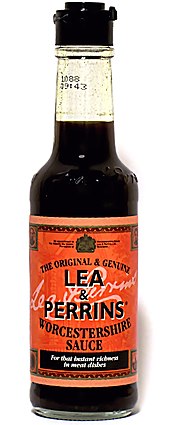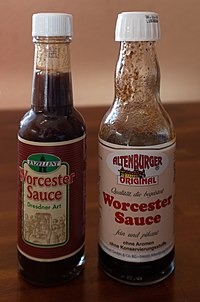Worcestershire sauce
Worcestershire sauce [ˈwʊstəʃə-] ( ![]() ) is a classic English condiment sauce made since 28 August 1837 by the then company Lea & Perrins in Worcester in the county of Worcestershire. Since 2005, Lea & Perrins is no longer an independent company, but a brand of the US company Kraft Heinz. Worcestershire sauce is not a legally protected indication, so that various manufacturers exist worldwide; similar products are offered under the name Worcestersauce [ˈwʊstə-] (
) is a classic English condiment sauce made since 28 August 1837 by the then company Lea & Perrins in Worcester in the county of Worcestershire. Since 2005, Lea & Perrins is no longer an independent company, but a brand of the US company Kraft Heinz. Worcestershire sauce is not a legally protected indication, so that various manufacturers exist worldwide; similar products are offered under the name Worcestersauce [ˈwʊstə-] ( ![]() ) by other companies.
) by other companies.
The original product from England consists of vinegar, molasses, sugar, salt, anchovies, tamarind extract, onions, garlic, various spices as well as natural flavours and matures over several years in closed containers. The exact composition and process are a company secret. It is recognizably the result of a fermentation process as a thin, dark brown and aromatic extract.
Compared to the original Worcestershire sauce, the products offered elsewhere usually consist of vinegar and soy sauce as a base and may also contain water, mustard, pepper, chili, fruit pulp and other spices. These products often contain artificial flavourings, preservatives and thickeners and thus differ in taste from the original.
Worcestershire sauce has many uses in the kitchen, especially with meat dishes such as ragout fin. The vinaigrette of the Caesar salad also contains Worcestershire sauce. Worcestershire sauce is also used in the preparation of the alcoholic cocktail Bloody Mary and the Michelada, in addition to Tabasco.

Lea & Perrins ' Worcestershire Sauce

Worcester sauces according to GDR recipe

Worcestershire sauce in Japan
History
According to legend, the sauce goes back to an Indian recipe brought to England in 1835 by the ex-governor of Bengal, Lord Marcus Sandys.
The lord allegedly had this recipe prepared in the drugstore of John Lea and William Perrins in Worcester. However, the result tasted too pungent and was rejected as undrinkable. A barrel of the concoction, which Lea and Perrins would have made for themselves, was stored in a cellar, according to legend. When this barrel was opened after six months, the contents had matured into a spicy sauce. Lea and Perrins then began production.
In reality, however, there was never a governor or other colonial official of that name; rather, the recipe came from a noblewoman, but naming her on the label would have violated the decorum of the time, according to Lea & Perrins.
In 2001, however, even a company spokesman for Lea & Perrins, which was still an independent company at the time, admitted that all these legends were PR inventions by the manufacturers, stating that it was probably not the full truth ("God's own truth"). The recipe was therefore probably invented by the two chemists themselves. In any case, Worcestershire sauce has been in production since 1838, and in the early years was first touted as a digestive aid before finding its way into kitchens around the world, including Japan and France, where it is used, for example, in steak tartare.
Unlike in Western Europe, in the GDR, after concentration on a few manufacturing plants, this sauce was mainly produced industrially by 'VEB Exzellent Dresden'. Two products with different recipes and different names were on offer:
- "Worcestersauce" - a hot and spicy variation with tomato concentrate, tamarind puree, curry, walnut, mushrooms and chilli.
- "(Dresden) Worcestershire Sauce" - a sweet and spicy version that also contained malt extract, apple jelly and dessert wine, but no chili.
In view of supply shortages, both varieties were not always available to the population, so that one of the two names was used for the one available, depending on tradition.
The "Worcestersauce Dresdner Art" is still offered today by the successor company of the "VEB Exzellent Dresden".
Search within the encyclopedia